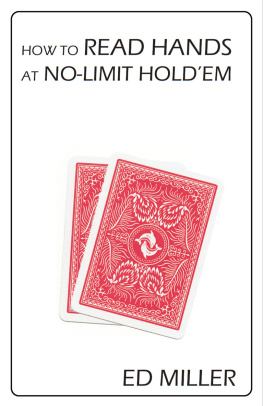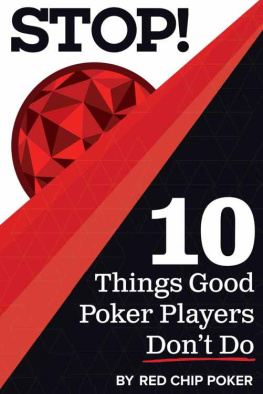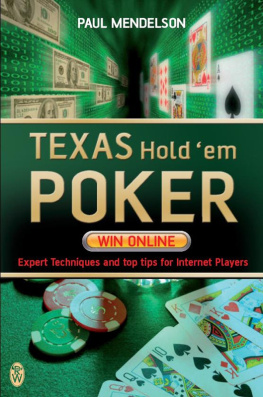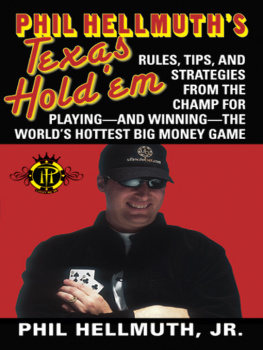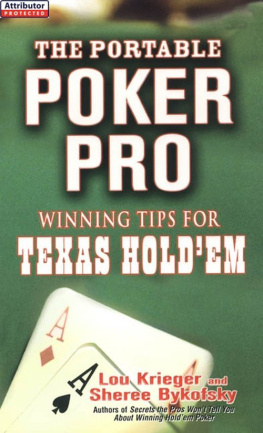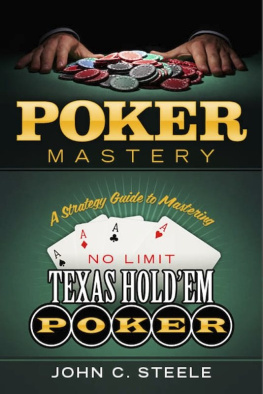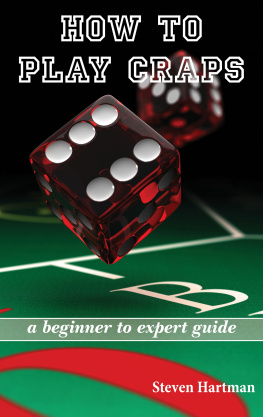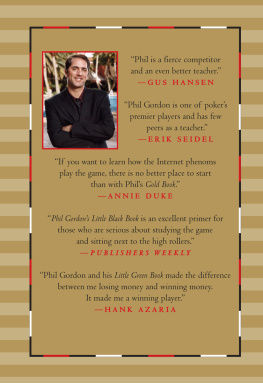NOTICE
This document is protected by United States copyright law. You may not reproduce, distribute, transmit, publish, or broadcast any part of it without the prior written permission of the author.
How To Read Hands
At No-Limit Holdem
Ed Miller
Copyright 2011 by Ed Miller
ALL RIGHTS RESERVED
No part of this document or the related files may be reproduced or transmitted in any form, by any means (electronic, photocopying, recording, or otherwise) without the prior written permission of the publisher.
For information about permission to reproduce selections from this book, write to Ed Miller, 9850 South Maryland Parkway, Suite A-5, Box 210, Las Vegas, NV 89183, United States of America.
www.notedpokerauthority.com
ISBN-13: 978-0-9825042-2-2
ISBN-10: 0-9825042-2-5
Limit of Liability and Disclaimer of Warranty: The publisher has used its best efforts in preparing this book , and the information provided herein is provided "as is." The publisher makes no representation or warranties with respect to the accuracy or completeness of the contents of this book and specifically disclaims any implied warranties of merchantability or fitness for any particular purpose and shall in no event be liable for any loss of profit or any other commercial damage, including but not limited to special, incidental, consequential, or other damages.
Trademarks: This book identifies product names and services known to be trademarks, registered trademarks, or service marks of their respective holders. They are used throughout this book in an editorial fashion only. In addition, terms suspected of being trademarks, registered trademarks, or service marks have been appropriately capitalized, although the publisher cannot attest to the accuracy of this information. Use of a term in this book should not be regarded as affecting the validity of any trademark, registered trademark, or service mark.
Contents
Contents 5
Introduction 6
Part I: Core Hand Reading 8
Player Types 9
The Three Principles Of Hand Reading 12
Hand Ranges 15
Hand Combinations 21
Preflop Hand Reading 23
Hand Reading On The Flop 33
Hand Reading On The Turn 56
Hand Reading On The River 78
PART II: HAND READING VARIATIONS 88
When Your Opponents Don't Cooperate 89
When Don't They Bet? 98
Getting Raised 107
Discounting Hand Combos 124
Polarized Hand Ranges 126
Hand Reading In Multiway Pots 133
Using Flopzilla To Perfect Your Hand Reading 138
Profiling Players Using Bayesian Inference 146
Quick Concepts And Key Points 159
PART III: HAND READING IN PRACTICE 166
Hand Reading In Practice 167
Conclusion 188
Acknowledgements 189
Introduction
Hand reading is the key to winning at no-limit hold'em. If you can read hands, you can win. If you can't, you'll struggle.
This book will teach you the hand reading skills needed to beat live no-limit games up to $5-$10, small stakes online games, and nearly any home game you might play in. The techniques in this book are also very useful for the early stages of no-limit hold'em tournaments when the stacks are still deep enough that every hand isn't all-in preflop.
A good hand reader who has mastered the concepts in this book should be able to clear $20 to $40 per hour in today's medium-level live games (i.e., $2-$5 or similar stakes).
Hand reading is the art of deducing your opponents' hands based on the available information. Information is available everywhere, from the betting action to the time it takes your opponents to act to body language to what your opponents are wearing. While all this information can play into hand reading, the betting action contains the most valuable information, and that's the information we'll use the most as we work through the examples in this book.
There's no magic or voodoo in this book. Poker players like to say things like, "Something just didn't feel right, and I could tell he didn't have it." None of that here. Some people do have a "feel" that is helpful to themmine is average at bestbut I won't try to teach you how to have accurate spidey sense.
This book takes a practical, example-driven approach. You'll work through hands and use a logical, repeatable process to read your opponents' hands. You don't have to be clairvoyant to read hands. You just need to think clearly, and then you need practice, practice, practice. This book will give your hand reading a big jump start.
Part I: Core Hand Reading
Player Types
Different players play differently. Tell me something I don't know, right?
Hand reading is obviously player-dependent. Even though no two players think and play exactly the same way, you can fairly categorize players into rough groups that are useful for hand reading. In this book we'll discuss hand reading against three specific player types:
The Nit
Nits are conservative. They are primarily driven by the fear of losing their stack. If you make a big bet and they have a hand they're not sure about, even if they suspect you of bluffing, nine times out of ten they will end up folding.
Because of this, you gain more information from their calls than you would against other player types. In general, their calling hands will be relatively strong. Often after a call you can pin them down to one of just a few specific hands because they would have folded anything weaker and raised anything stronger. We'll discuss this in depth later.
The Fish
Fish is a generic term for a bad player. For the purpose of this book, a fish is someone primarily driven by the thrill of winning pots. Where nits are terrified of losing a big pot, losing doesn't worry the fish nearly as much. Instead, they are constantly seeking to make hands and win pots.
Because of this, you gain much less information from their calls than you would against other player types. They call with all sorts of hands, hoping to get lucky. This aspect of playing against a fish frustrates many players, because it can feel like you're playing blind against them. "You play so many hands you could have anything" is something you'll hear grizzled veterans say from time to time to a fish.
Nevertheless, hand reading is still extremely useful when playing against a fish.
The Regular
Regulars have been around the block. They don't play in constant fear, nor do they obsessively chase longshots. When used to describe an online medium stakes player, the term "regular" describes someone who is actually very, very good at no-limit hold'em. That's not who I'm talking about.
Our regulars are the "solid" players who fill out $1-$2, $2-$5, and $5-$10 games in cardrooms. They're the "sharks" in most home games. They tend to play a predictable game that makes reading their hands fairly easy. They also make plenty of poor plays as a matter of habit, and they can be manipulated into making even worse plays.
In short, regulars tend not to make many eye-poppingly stupid plays, but if you learn to read their hands well, you will have a big advantage over them.
There's another important player type that I'm avoiding in this book: The Tough Player. Tough players read hands well and play an aggressive game designed to put pressure on you when they deduce that you are likely to have a weak hand. If you play online at the $1-$2 level and above, you'll encounter plenty of tough players. These guys already know what's in this book and are using it against you.
You can use the principles in this book to read tough players' hands. But tough players know you're reading their hands and mix up their play to thwart you. Learning to spar with these players is beyond the scope of this book.
Next page
